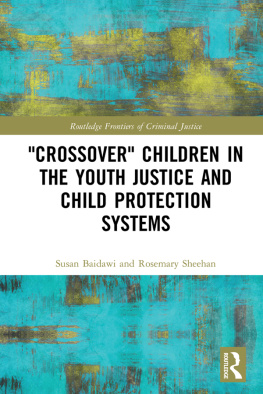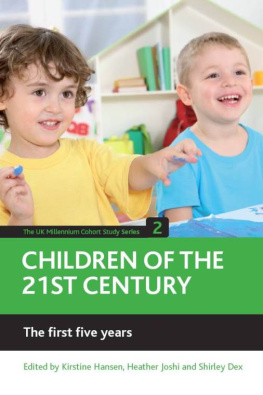Defining and Classifying Children in Need
The Library of Essays in Child Welfare and Development
Series Editor: Michael Little
Titles in the Series:
Defining and Classifying Children in Need
NickAxford
The Law and Child Development
Emily Buss and Mavis Maclean
Children in State Care
Mark Courtney and June Thoburn
Effective Interventions for Children in Need
Michael Little and Barbara Maughan
Childrens Services in the Developing World
Dwan Kaoukji and Najat MJid
Child Development
Barbara Maughan and Michael Little
Defining and Classifying
Children in Need
Edited by
Nick Axford
Dartington Social Research Unit, UK

2 Park Square, Milton Park, Abingdon, Oxon OX14 4RN
Taylor & Francis Group, LLC
Routledge is an imprint of the Taylor & Francis Group, an informa business
Copyright Nick Axford 2009. For copyright of individual articles please refer to the Acknowledgements.
All rights reserved. No part of this publication may be reproduced, stored in a retrieval system or transmitted in any form or by any means, electronic, mechanical, photocopying, recording or otherwise without the prior permission of the publisher.
Notice:
Product or corporate names may be trademarks or registered trademarks, and are used only for identification and explanation without intent to infringe.
Wherever possible, these reprints are made from a copy of the original printing, but these can themselves be of very variable quality. Whilst the publisher has made every effort to ensure the quality of the reprint, some variability may inevitably remain.
British Library Cataloguing in Publication Data
Defining and Classifying Children in Need. - ( The Library
of Essays in Child Welfare and Development)
1. Child welfare 2. Family assessment 3. Children
services for
I. Axford, Nick
362.7
Library of Congress Cataloging-in-Publication Data
Defining and Classifying Children in Need / edited by Nick Axford.
p. cm.
Includes index.
1. Child Welfare. 2. Family assessment. 3. Children-Services for. I. Axford, Nick.
HV715. D445 2008
362.7-dc22
2008002373
ISBN 9780754625568 (hbk)
ISBN: 978-1-3152-5832-4 (ebk)
Contents
Government and Opposition, , pp. 297314.
Philosophy and Phenomenological Research, , pp. 61525.
Critical Social Policy, 4, pp. 638.
New Left Review, , pp. 11328.
Social Science Medicine, , pp. 72730.
in G. McLachlan (ed.), Problems and Progress in Medical Care, Oxford University Press, pp. 7182.
Psychological Review, 50, pp. 37096.
Child and Family Social Work, , pp. 10920.
Journal of Child Psychology and Psychiatry, , pp. 58185.
Children & Society, , pp. 192201.
Evaluation, Aberdeen: University of Aberdeen Department of Social Work, pp. 4057.
International Journal of Health Services, , pp. 71548.
Policy and Politics, , pp. 2934.
British Journal of Social Work, , pp. 25575.
Research, Policy and Practice, (3), pp. 2838
Journal of Integrated Care, (3), pp.310.
Research Polich and Planning, (2), pp. 17.
Development and Psychopathology, , pp. 50927.
Children & Society, , pp. 30416.
Journal of Integrated Care, (4), pp. 1223.
Acknowledgements
The editor and publishers wish to thank the following for permission to use copyright material.
American Psychological Association for the essay: A.H. Maslow (1943), A Theory of Human Motivation, Psychological Review, 50, pp. 37096. Copyright 1943 American Psychological Association.
BAAF Publications for the essay: Dora Black (1990), What Do Children Need from Parents?, Adoption & Fostering, 14, pp. 4351. Copyright 1990 BAAF Publications.
Baywood Publishing for the essay: Ian Gough and Theo Thomas (1994), Why Do Levels of Human Welfare Vary Among Nations?, International Journal of Health Services, 24, pp. 71548. Copyright 1994 Baywood Publishing Co., Inc.
Blackwell Publishing for the essays : Raymond Plant (1985), Welfare and the Value of Liberty, Government and Opposition, 20, pp. 297314. Copyright 1985 Blackwell Publishing Ltd; Robert E. Goodin (1985), The Priority of Needs, Philosophy and Phenomenological Research, 45, pp. 61525. Copyright 1985 Blackwell Publishing Ltd; Michael Rutter (1989), Pathways from Childhood to Adult Life, Journal of Child Psychology and Psychiatry, 30, pp. 2351. Copyright 1989 Association for Child Psychology and Psychiatry, published by Blackwell Publishing Ltd and reproduced with permission; Gordon Jack (1997), An Ecological Approach to Social Work with Children and Families, Child and Family Social Work, 2, pp. 10920. Copyright 1997 Blackwell Publishing Ltd; Robert Goodman (1997), The Strengths and Difficulties Questionnaire: A Research Note, Journal of Child Psychology and Psychiatry, 38, pp. 58185. Copyright 1997 Association for Child Psychology and Psychiatry, published by Blackwell Publishing Ltd and reproduced with permission; Dennis P. Cantwell (1996), Classification of Child and Adolescent Psychopathology, Journal of Child Psychology and Psychiatry, 37, pp. 312. Copyright 1996 Blackwell Publishing Ltd; Roy Parker (1998), Reflections on the Assessment of Outcomes in Child Care, Children & Society, 12, pp. 192201. Copyright 1998 Blackwell Publishing Ltd; Michael Little (1999), Prevention and Early Intervention with Children in Need: Definitions, Principles and Examples of Good Practice, Children & Society, 13, pp. 30416. Copyright 1999 Blackwell Publishing Ltd.
Cambridge University Press for the essay: Conduct Problems Prevention Research Group (1992), A Developmental and Clinical Model for the Prevention of Conduct Disorder: The FAST Track Program, Development and Psychopathology, 4, pp. 50927. Copyright 1992 Cambridge University Press.
Elsevier for the essay: A.J. Culyer (1995), Need: The Idea Wont Do But We Still Need It, Social Science Medicine, 40, pp. 72730. Copyright 1995 Elsevier Ltd.
New Left Review for the essay: Kate Soper (1993), A Theory of Human Need, New Left Review, 197, pp. 11328. Copyright 1993 The New Left Review.
Oxford University Press for the essays: Michael Preston-Shoot and Veronica Wigley (2005), Mapping the Needs of Children in Need, British Journal of Social Work, 35, pp. 25575. Copyright 2005 Michael Preston-Shoot and Veronica Wigley, published by Oxford University Press and reproduced with permission; Andrew Bebbington and John Miles (1989), The Background of Children Who Enter Local Authority Care, British Journal of Social Work, 19, pp. 34968. Copyright 1989 British Association of Social Workers, published by Oxford University Press and reproduced with permission.







